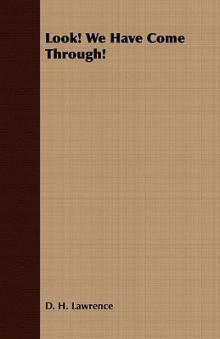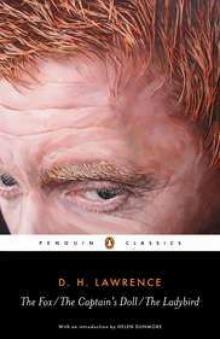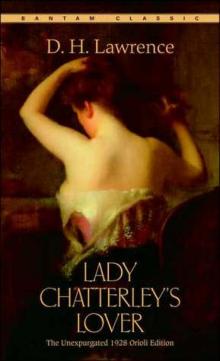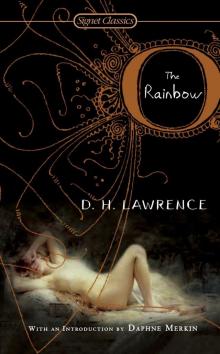- Home
- D. H. Lawrence
Life with a Capital L Page 7
Life with a Capital L Read online
Page 7
So Raphael, knowing that his desire reaches out beyond the range of possible experience, sensible that he will not find satisfaction in any one woman, sensible that the female impulse does not, or cannot unite in him with the male impulse sufficiently to create a stability, an eternal moment of truth for him, of realization, closes his eyes and his mind upon experience, and abstracting himself, reacting upon himself, produces the geometric conception of the fundamental truth, departs from religion, from any God idea, and becomes philosophic.
Raphael is the real end of Renaissance in Italy; almost he is the real end of Italy, as Plato was the real end of Greece. When the God-idea passes into the philosophic or geometric idea, then there is a sign that the male impulse has thrown the female impulse, and has recoiled upon itself, has become abstract, asexual.
Michelangelo, however, too physically passionate, containing too much of the female in his body ever to reach the geometric abstraction, unable to abstract himself, and at the same time, like Raphael, unable to find any woman who in her being should resist him and reserve still some unknown from him, strives to obtain his own physical satisfaction in his art. He is obsessed by the desire of the body. And he must react upon himself to produce his own bodily satisfaction, aware that he can never obtain it through woman. He must seek the moment, the consummation, the keystone, the pivot, in his own flesh. For his own body is both male and female.
Raphael and Michelangelo are men of different nature placed in the same position and resolving the same question in their several ways. Socrates and Plato are a parallel pair, and, in another degree, Tolstoi and Turgeniev, and, perhaps, St Paul and St John the Evangelist, and, perhaps, Shakespeare and Shelley.
The body it is which attaches us directly to the female. Sex, as we call it, is only the point where the dual stream begins to divide, where it is nearly together, almost one. An infant is of no very determinate sex: that is, it is of both. Only at adolescence is there a real differentiation, the one is singled out to predominate. In what we call happy natures, in the lazy, contented people, there is a fairly equable balance of sex. There is sufficient of the female in the body of such a man as to leave him fairly free. He does not suffer the torture of desire of a more male being. It is obvious even from the physique of such a man that in him there is a proper proportion between male and female, so that he can be easy, balanced, and without excess. The Greek sculptors of the “best” period, Phidias and then Sophocles, Alcibiades, then Horace, must have been fairly well-balanced men, not passionate to any excess, tending to voluptuousness rather than to passion. So also Victor Hugo and Schiller and Tennyson. The real voluptuary is a man who is female as well as male, and who lives according to the female side of his nature, like Lord Byron.
The pure male is himself almost an abstraction, almost bodiless, like Shelley or Edmund Spenser. But, as we know humanity, this condition comes of an omission of some vital part. In the ordinary sense, Shelley never lived. He transcended life. But we do not want to transcend life, since we are of life.
Why should Shelley say of the skylark:
‘Hail to thee, blithe Spirit! – bird thou never wert! –’? Why should he insist on the bodilessness of beauty, when we cannot know of any save embodied beauty? Who would wish that the skylark were not a bird, but a spirit? If the whistling skylark were a spirit, then we should all wish to be spirits. Which were impious and flippant.
I can think of no being in the world so transcendently male as Shelley. He is phenomenal. The rest of us have bodies which contain the male and the female. If we were so singled out as Shelley, we should not belong to life, as he did not belong to life. But it were impious to wish to be like the angels. So long as mankind exists it must exist in the body, and so long must each body pertain both to the male and the female.
In the degree of pure maleness below Shelley are Plato and Raphael and Wordsworth, then Goethe and Milton and Dante, then Michelangelo, then Shakespeare, then Tolstoi, then St Paul.
A man who is well balanced between male and female, in his own nature, is, as a rule, happy, easy to mate, easy to satisfy, and content to exist. It is only a disproportion, or a dissatisfaction, which makes the man struggle into articulation. And the articulation is of two sorts, the cry of desire or the cry of realization, the cry of satisfaction, the effort to prolong the sense of satisfaction, to prolong the moment of consummation.
A bird in spring sings with the dawn, ringing out from the moment of consummation in wider and wider circles. Dürer, Fra Angelico, Botticelli, all sing of the moment of consummation, some of them still marvelling and lost in the wonder at the other being, Botticelli poignant with distinct memory. Raphael too sings of the moment of consummation. But he was not lost in the moment, only sufficiently lost to know what it was. In the moment, he was not completely consummated. He must strive to complete his satisfaction from himself. So, whilst making his great acknowledgment to the Woman, he must add to her to make her whole, he must give her his completion. So he rings her round with pure geometry, till she becomes herself almost of the geometric figure, an abstraction. The picture becomes a great ellipse crossed by a dark column. This is the Madonna degli Ansidei. The Madonna herself is almost insignificant. She and the child are contained within the shaft thrust across the ellipse.
This column must always stand for the male aspiration, the arch or ellipse for the female completeness containing this aspiration. And the whole picture is a geometric symbol of the consummation of life.
What we call the Truth is, in actual experience, that momentary state when in living the union between the male and the female is consummated. This consummation may be also physical, between the male body and the female body. But it may be only spiritual, between the male and female spirit.
And the symbol by which Raphael expresses this moment of consummation is by a dark, strong shaft or column leaping up into, and almost transgressing a faint, radiant, inclusive ellipse.
To express the same moment Botticelli uses no symbol, but builds up a complicated system of circles, of movements wheeling in their horizontal plane about their fixed centres, the whole builded up dome-shape, and then the dome surpassed by another singing cycle in the open air above.
This is Botticelli always: different cycles of joy, different moments of embrace, different forms of dancing round, all contained in one picture, without solution. He has not solved it yet.
And Raphael, in reaching the pure symbolic solution, has surpassed art and become almost mathematics. Since the business of art is never to solve, but only to declare.
There is no such thing as solution. Nietzsche talks about the Ewige Wiederkehr. It is like Botticelli singing cycles. But each cycle is different. There is no real recurrence.
And to single out one cycle, one moment, and to exclude from this moment all context, and to make this moment timeless, this is what Raphael does, and what Plato does. So that their absolute Truth, their geometric Truth, is only true in timelessness.
Michelangelo, on the other hand, seeks for no absolute Truth. His desire is to realize in his body, in his feeling, the moment-consummation which is for Man the perfect truth-experience. But he knows of no embrace. For him, personally, woman does not exist. For Botticelli she existed as the Virgin-Mother, and as the Primavera, and as Aphrodite. She existed as the pure origin of life on the female side, as the bringer of light and delight, and as the passionately Desired of every man, as the Known and Unknown in one: to Raphael she existed either as a minor part of his experience, having nothing to do with his aspiration, or else his aspiration merely used her as a statement included within the Great Abstraction.
To Michelangelo the female scarcely existed outside his own physique. There he knew of her and knew the desire of her. But Raphael, in his passion to be self-complete, roused his desire for consummation to a white-hot pitch, so that he became incandescent, reacting on himself, consuming his own flesh and his own bodily life, to reach the pitch of perfect abstraction, the resisting
body holding back the raging stream of outward force, till the two formed a stable incandescence, a luminous geometric conception of permanence and inviolability. Meanwhile his body burned away, overpowered, in this state of incandescence.
Michelangelo’s will was different. The body in him, that which knew of the female and therefore was the female, was stronger and more insistent. His desire for consummation was desire for the satisfying moment when the male and female spirits touch in closest embrace, vivifying each other, not one destroying the other, but still are two. He knew that for Man consummation is a temporal state. The pure male spirit must ever conceive of timelessness, the pure female of the moment. And Michelangelo, more mixed than Raphael, must always rage within the limits of time and of temporal forms. So he reacted upon himself, sought the female in himself, aggrandized it, and so reached a wonderful momentary stability of flesh exaggerated till it became tenuous, but filled and balanced by the outward-pressing force. And he reached his consummation in that way, reached the perfect moment, when he realized and revealed his figures in all their marvellous equilibrium. The Jewish tradition, with its great physical God, source of male and female, attracted him. By turning towards the female goal, of utter stability and permanence in Time, he arrived at his consummation. But only by reacting on himself, by withdrawing his own mobility. Thus he made his great figures, the Moses, static and looming, announcing, like the Jewish God, the magnificence and eternality of the physical law; the David, young, but with too much body for a young figure, the physique exaggerated, the clear, outward-leaping, essential spirit of the young man smothered over, the real maleness cloaked, so that the statue is almost a falsity. Then the slaves, heaving in body, fastened in bondage that refuses them movement; the motionless Madonna, no Virgin but Woman in the flesh, not the pure female conception, but the spouse of man, the mother of bodily children. The men are not male, nor the women female, to any degree.
The Adam can scarcely stir into life. That large body of almost transparent, tenuous texture is not established enough for motion. It is not that it is too ponderous: it is too unsubstantial, unreal. It is not motion, life, he craves, but body. Give him but a firm, concentrated physique. That is the cry of all Michelangelo’s pictures.
But, powerful male as he was, he satisfies his desire by insisting upon and exaggerating the body in him, he reaches the point of consummation in the most marvellous equilibrium which his figures show. To attain this equilibrium he must exaggerate and exaggerate and exaggerate the flesh, make it ever more tenuous, keeping it really in true ratio. And then comes the moment, the perfect stable poise, the perfect balance between object and movement, the perfect combination of male and female in one figure.
It is wonderful, and peaceful, this equilibrium, once reached. But it is reached through anguish and self-battle and self-repression, therefore it is sad. Always, Michelangelo’s pictures are full of joy, of self-acceptance and self-proclamation. Michelangelo fought and arrested the mobile male in him; Raphael was proud in the male he was, and gave himself utter liberty, at the female expense.
And it seems as though Italy had ever since the Renaissance been possessed by the Raphaelesque conception of the ultimate geometric basis of life, the geometric essentiality of all things. There is in the Italian, at the very bottom of all, the fundamental, geometric conception of absolute static combination. There is the shaft enclosed in the ellipse, as a permanent symbol. There exists no shaft, no ellipse separately, but only the whole complete thing; there is neither male nor female, but an absolute interlocking of the two in one, an absolute combination, so that each is gone in the complete identity. There is only the geometric abstraction of the moment of consummation, a moment made timeless. And this conception of a long, clinched, timeless embrace, this overwhelming conception of timeless consummation, of which there is no beginning nor end, from which there is no escape, has arrested the Italian race for three centuries. It is the source of its indifference and its fatalism and its positive abandon, and of its utter incapacity to be sceptical, in the Russian sense.
This conception contains also, naturally, as part of the same idea, Aphrodite-worship and Phallic-worship. But these are subordinate, and belong to a sort of initiatory period. The real conception, for the individual, is marriage, inviolable marriage, which always was and always has been, no matter what apparent aberrations there may or may not be. And the manifestation of divinity is the child. In marriage, in utter, interlocked marriage, man and woman cease to be two beings and become one, one and one only, not two in one as with us, but absolute One, a geometric absolute, timeless, the Absolute, the Divine. And the child, as issue of this divine and timeless state, is hailed with love and joy.
But the Italian is now beginning to withdraw from his clinched and timeless embrace, from his geometric abstraction, into the northern conception of himself and the woman as two separate identities, which meet, combine, but always must withdraw again.
So that the Futurist Boccioni now makes his sculpture, Development of a Bottle through Space, try to express the withdrawal, and at the same time he must adhere to the conception of this same interlocked state of marriage between centripetal and centrifugal forces, the geometric abstraction of the bottle. But he can neither do one thing nor the other. He wants to re-state the real abstraction. And at the same time he has an unsatisfied desire to satisfy. He must insist on the centrifugal force, and so destroy at once his abstraction. He must insist on the male spirit of motion outwards, because, during three static centuries, there has necessarily come to pass a preponderance of the female in the race, so that the Italian is rather more female than male now, as is the whole Latin race rather voluptuous than passionate, too much aware of their utter lockedness male with female, and too hopeless, as males, to act, to be passionate. So that when I look at Boccioni’s sculpture, and see him trying to state the timeless abstract being of a bottle, the pure geometric abstraction of the bottle, I am fascinated. But then, when I see him driven by his desire for the male complement into portraying motion, simple motion, trying to give expression to the bottle in terms of mechanics, I am confused. It is for science to explain the bottle in terms of force and motion. Geometry, pure mathematics, is very near to art, and the vivid attempt to render the bottle as a pure geometric abstraction might give rise to a work of art, because of the resistance of the medium, the stone. But a representation in stone of the lines of force which create that state of rest called a bottle, that is a model in mechanics.
And the two representations require two different states of mind in the appreciator, so that the result is almost nothingness, mere confusion. And the portraying of a state of mind is impossible. There can only be made scientific diagrams of states of mind. A state of mind is a resultant between an attack and a resistance. And how can one produce a resultant without first causing the collision of the originating forces?
The attitude of the Futurists is the scientific attitude, as the attitude of Italy is mainly scientific. It is the forgetting of the old, perfect Abstraction, it is the departure of the male from the female, it is the act of withdrawal: the denying of consummation and the starting afresh, the learning of the alphabet.
Chapter 8
The Light of the World
The climax that was reached in Italy with Raphael has never been reached in like manner in England. There has never been, in England, the great embrace, the surprising consummation, which Botticelli recorded and which Raphael fixed in a perfect Abstraction.
Correggio, Andrea del Sarto, both men of less force than those other supreme three, continued the direct line of development, turning no curve. They still found women whom they could not exhaust: in them, the male still reacted upon the incontrovertible female. But ever there was a tendency to greater movement, to a closer characterization, a tendency to individualize the human being, and to represent him as being embedded in some common, divine matrix.
Till after the Renaissance, supreme God had always been God th
e Father. The Church moved and had its being in Almighty God, Christ was only the distant, incandescent gleam towards which humanity aspired, but which it did not know.
Raphael and Michelangelo were both servants of the Father, of the Eternal Law, of the Prime Being. Raphael, faced with the question of Not-Being, when it was forced upon him that he would never accomplish his own being in the flesh, that he would never know completeness, the momentary consummation, in the body, accomplished the Geometrical Abstraction, which is the abstraction from the Law, which is the Father.
There was, however, Christ’s great assertion of Not-Being, of No-Consummation, of life after death, to reckon with. It was after the Renaissance, Christianity began to exist. It had not existed before.
In God the Father we are all one body, one flesh. But in Christ we abjure the flesh, there is no flesh. A man must lose his life to save it. All the natural desires of the body, these a man must be able to deny, before he can live. And then, when he lives, he lives, he shall live in the knowledge that he is himself, so that he can always say: ‘I am I.’
In the Father we are one flesh, in Christ we are crucified, and rise again, and are One with Him in Spirit. It is the difference between Law and Love. Each man shall live according to the Law, which changeth not, says the old religion. Each man shall live according to Love, which shall save us from death and from the Law, says the new religion.
But what is Love? What is the deepest desire Man has yet known? It is always for this consummation, this momentary contact or union of male with female, of spirit with spirit and flesh with flesh, when each is complete in itself and rejoices in its own being, when each is in himself or in herself complete and single and essential. And love is the great aspiration towards this complete consummation and this joy; it is the aspiration of each man that all men, that all life, shall know it and rejoice. Since, until all men shall know it, no man shall fully know it. Since, by the Law, we are all one flesh. So that Love is only a closer vision of the Law, a more comprehensive interpretation: ‘Think not I come to destroy the Law, or the Prophets: I come not to destroy, but to fulfil. For verily I say unto you, till heaven and earth pass, one jot or one tittle shall in no wise pass from the Law, till all be fulfilled.’

 Look! We Have Come Through!
Look! We Have Come Through! Women in Love
Women in Love The Ladybird
The Ladybird The Rainbow
The Rainbow The Captain's Dol
The Captain's Dol The White Peacock
The White Peacock Amores
Amores Lady Chatterley's Lover
Lady Chatterley's Lover Touch and Go
Touch and Go The Wintry Peacock
The Wintry Peacock Life with a Capital L
Life with a Capital L The Lost Girl
The Lost Girl Sons and Lovers
Sons and Lovers England, My England
England, My England New Poems
New Poems Twilight in Italy
Twilight in Italy The Trespasser
The Trespasser The Collected Short Stories
The Collected Short Stories The First Lady Chatterley's Lover
The First Lady Chatterley's Lover Kangaroo
Kangaroo Bay
Bay Complete Works of D.H. Lawrence
Complete Works of D.H. Lawrence D H Lawrence- The Dover Reader
D H Lawrence- The Dover Reader The Rainbow (100th Anniversary ed.)
The Rainbow (100th Anniversary ed.) The Prussian Officer
The Prussian Officer Women in Love (Barnes & Noble Classics Series)
Women in Love (Barnes & Noble Classics Series) John Thomas and Lady Jane
John Thomas and Lady Jane The Bad Side of Books
The Bad Side of Books Sons and Lovers (Barnes & Noble Classics Series)
Sons and Lovers (Barnes & Noble Classics Series) Selected Stories
Selected Stories Collected Short Stories
Collected Short Stories Complete Works of D.H. Lawrence (Illustrated)
Complete Works of D.H. Lawrence (Illustrated)